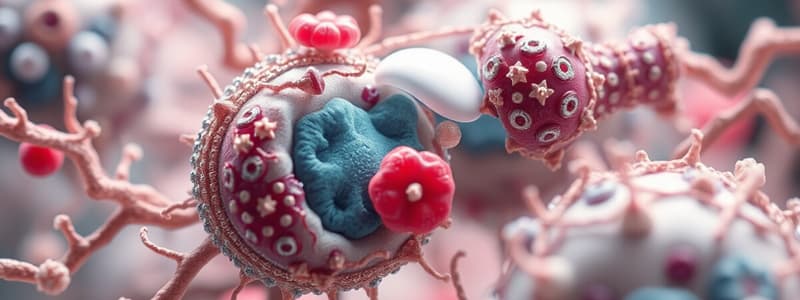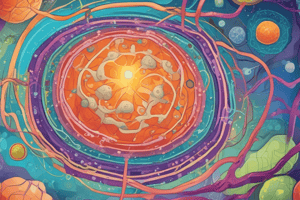Podcast
Questions and Answers
What is the primary function of the biconcave shape of red blood cells?
What is the primary function of the biconcave shape of red blood cells?
- To increase surface area for efficient oxygen transport. (correct)
- To enable the cells to squeeze through narrow capillaries.
- To protect the cell's DNA from damage.
- To facilitate the transport of carbon dioxide.
What is the primary function of the cell wall in plant cells?
What is the primary function of the cell wall in plant cells?
- To provide a rigid and porous structure for support and protection. (correct)
- To regulate the passage of materials in and out of the cell.
- To carry out cellular respiration.
- To store water, nutrients, and waste products.
Which component of blood is responsible for fighting infections?
Which component of blood is responsible for fighting infections?
- Red blood cells
- Platelets
- White blood cells (correct)
- Plasma
What causes turgor pressure in plant cells?
What causes turgor pressure in plant cells?
How do villi and microvilli contribute to the function of the small intestine?
How do villi and microvilli contribute to the function of the small intestine?
Which of the following is the correct equation for photosynthesis?
Which of the following is the correct equation for photosynthesis?
What is the role of hemoglobin in red blood cells?
What is the role of hemoglobin in red blood cells?
How are cellular respiration and photosynthesis complementary processes?
How are cellular respiration and photosynthesis complementary processes?
What is the primary function of alveoli in the lungs?
What is the primary function of alveoli in the lungs?
Which of the following explains how blood doping enhances athletic performance?
Which of the following explains how blood doping enhances athletic performance?
Which of these structures are found in a plant cell but NOT in an animal cell?
Which of these structures are found in a plant cell but NOT in an animal cell?
What is the main component of blood plasma?
What is the main component of blood plasma?
Which of the following is TRUE about plant cell shapes?
Which of the following is TRUE about plant cell shapes?
During interphase, what is the key event that prepares the cell for division?
During interphase, what is the key event that prepares the cell for division?
Which characteristic of muscle cells allows them to cause movement of bones?
Which characteristic of muscle cells allows them to cause movement of bones?
Why is interphase considered a crucial stage in the cell cycle?
Why is interphase considered a crucial stage in the cell cycle?
Which cellular component is primarily responsible for controlling all cell activities?
Which cellular component is primarily responsible for controlling all cell activities?
What is the function of the cristae found within the mitochondria?
What is the function of the cristae found within the mitochondria?
Which organelle is involved in the synthesis of proteins?
Which organelle is involved in the synthesis of proteins?
Which cellular structure is responsible for modifying and packaging materials for secretion from the cell?
Which cellular structure is responsible for modifying and packaging materials for secretion from the cell?
Which organelle is known as the 'suicide sac' due to its role in cell death?
Which organelle is known as the 'suicide sac' due to its role in cell death?
What is the function of the cell membrane?
What is the function of the cell membrane?
Which of the following best describes the function of vacuoles?
Which of the following best describes the function of vacuoles?
What is the main role of the endoplasmic reticulum (ER)?
What is the main role of the endoplasmic reticulum (ER)?
During which phase of mitosis do sister chromatids separate and move to opposite poles of the cell?
During which phase of mitosis do sister chromatids separate and move to opposite poles of the cell?
What is the main function of the spindle fibers during mitosis?
What is the main function of the spindle fibers during mitosis?
When does the nuclear membrane begin to break down during mitosis?
When does the nuclear membrane begin to break down during mitosis?
What best describes the structure of a chromosome before anaphase?
What best describes the structure of a chromosome before anaphase?
During which phase of mitosis are chromosomes easily visible and lined up along the middle of the cell?
During which phase of mitosis are chromosomes easily visible and lined up along the middle of the cell?
Which event marks the beginning of telophase?
Which event marks the beginning of telophase?
What is the primary function of cellular differentiation?
What is the primary function of cellular differentiation?
What is the function of a centromere?
What is the function of a centromere?
Flashcards
Nucleus
Nucleus
The control center of the cell, containing chromosomes made of DNA. DNA carries coded instructions for all cell activities.
Cell Membrane
Cell Membrane
A double-layered structure that surrounds the cell, providing support and regulating what enters and exits.
Mitochondria
Mitochondria
Powerhouses of the cell, converting energy stored in glucose into usable energy for cellular processes.
Endoplasmic Reticulum (ER)
Endoplasmic Reticulum (ER)
Signup and view all the flashcards
Ribosomes
Ribosomes
Signup and view all the flashcards
Golgi Bodies
Golgi Bodies
Signup and view all the flashcards
Lysosomes
Lysosomes
Signup and view all the flashcards
Vacuoles
Vacuoles
Signup and view all the flashcards
Prophase
Prophase
Signup and view all the flashcards
Metaphase
Metaphase
Signup and view all the flashcards
Anaphase
Anaphase
Signup and view all the flashcards
Telophase
Telophase
Signup and view all the flashcards
Cellular Differentiation
Cellular Differentiation
Signup and view all the flashcards
Specialized Cell
Specialized Cell
Signup and view all the flashcards
Stem Cells
Stem Cells
Signup and view all the flashcards
Red Blood Cell Structure
Red Blood Cell Structure
Signup and view all the flashcards
What is the cell wall?
What is the cell wall?
Signup and view all the flashcards
What is the central vacuole?
What is the central vacuole?
Signup and view all the flashcards
Explain photosynthesis.
Explain photosynthesis.
Signup and view all the flashcards
What is cellular respiration?
What is cellular respiration?
Signup and view all the flashcards
How are photosynthesis and cellular respiration related?
How are photosynthesis and cellular respiration related?
Signup and view all the flashcards
What happens during interphase?
What happens during interphase?
Signup and view all the flashcards
Why is DNA replication important during interphase?
Why is DNA replication important during interphase?
Signup and view all the flashcards
What is mitosis?
What is mitosis?
Signup and view all the flashcards
Villi
Villi
Signup and view all the flashcards
Microvilli
Microvilli
Signup and view all the flashcards
Biconcave shape of red blood cells
Biconcave shape of red blood cells
Signup and view all the flashcards
Alveoli
Alveoli
Signup and view all the flashcards
Hemoglobin
Hemoglobin
Signup and view all the flashcards
Anemia
Anemia
Signup and view all the flashcards
Blood doping
Blood doping
Signup and view all the flashcards
Plasma
Plasma
Signup and view all the flashcards
Study Notes
Cellular Organelles
-
Cytoplasm: Mostly water, chemical reactions change its consistency, allowing organelles to move freely. Surrounds, supports, and selectively allows substances into the cell.
-
Cell Membrane: Flexible, double-layered structure surrounding the cell, controlling substance passage.
-
Nucleus: Contains genetic material (chromosomes), directing cell activities. DNA replicates before cell division.
-
Mitochondria: Produce energy for the cell by converting glucose's stored energy. Cells with high energy needs, like muscle cells, have more mitochondria.
-
Endoplasmic Reticulum (ER): Network of branching tubes. Rough ER has ribosomes, involved in protein production. Smooth ER, without ribosomes, is involved in other metabolic processes.
-
Ribosomes: Produce proteins. Can be free-floating or attached to the rough ER.
-
Golgi Bodies: Process and package materials for removal from the cell. Secrete mucus, and other similar functions.
-
Lysosomes: Contain digestive enzymes, destroying worn-out organelles or harmful substances. Sometimes called "suicide sacs" due to their role in cell death.
-
Vacuoles: Membrane-enclosed sacs containing various substances. Maintaining internal pressure (turgor) is an important function. Animal cells have many small vacuoles, while plant cells have a large central vacuole.
Plant Cell Specifics
-
Cell Wall: Rigid, porous structure made of cellulose. Found outside the cell membrane. Provides support and shape to plant cells.
-
Vacuole: Large, central vacuole in plant cells that is very important for maintaining turgor pressure. Turgor pressure is what keeps plants firm and upright.
-
Chloroplasts: Contain chlorophyll, a green pigment. Absorb sunlight energy for photosynthesis, converting carbon dioxide and water into glucose (sugar) and oxygen.
Cellular Processes
-
Photosynthesis Equation: Carbon dioxide + Water + Sunlight Energy → Glucose + Oxygen
-
Cellular Respiration Equation: Glucose + Oxygen → Carbon dioxide + Water + Energy
-
Complementarity: Photosynthesis products are cellular respiration reactants, illustrating a vital connection between these processes.
Cell Cycle
-
Interphase: Longest stage. DNA replication and organelle formation occur.
-
Chromatin: Threadlike strands of DNA during interphase.
Mitosis Stages
- Prophase: Chromatin condenses into chromosomes. Nuclear membrane and nucleolus disappear.
- Metaphase: Chromosomes align at the cell's equator (metaphase plate).
- Anaphase: Sister chromatids separate and move to opposite poles of the cell.
- Telophase: Chromosomes uncoil (return to chromatin), nuclear membranes reform, and the cell begins to divide.
Cellular Differentiation
-
Specialized Cells: Cells perform specific functions.
-
Stem Cells: All cells start as identical stem cells.
-
Differentiation: The process of transformation from identical stem cells to specialized functions.
Specific Cell Examples
-
Red Blood Cells: Biconcave shape maximizes surface area for oxygen transport.
-
Nerve Cells: Long, fiber-like extensions carry messages.
-
Muscle Cells: Long and thin, allowing for contraction and movement.
Surface Area Maximization
-
Villi and Microvilli (intestine): Folds increase surface area for nutrient absorption.
-
Red Blood Cells: Biconcave shape maximizes surface area for oxygen absorption and release.
-
Alveoli (lungs): Cup-shaped air sacs with a vast surface area for gas exchange.
Blood Components
-
Plasma: Liquid component, carries blood cells.
-
Red Blood Cells: Transport oxygen.
-
White Blood Cells: Fight infection.
-
Platelets: Involved in blood clotting.
Studying That Suits You
Use AI to generate personalized quizzes and flashcards to suit your learning preferences.
Related Documents
Description
Test your knowledge of cellular organelles with this quiz. Explore the functions and significance of key structures like the nucleus, mitochondria, and endoplasmic reticulum. Perfect for students studying cell biology.




